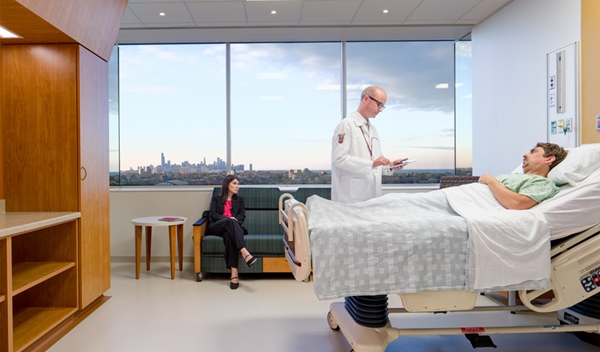26 May 2017. The opening of a new hospital in Chicago offered an opportunity to follow the formation of bacterial communities and their movement in a health care facility. Researchers from University of Chicago that owns the hospital led the study, who reported their results in the 24 May issue of the journal Science Translational Medicine (paid subscription required).
A team led by Jack Gilbert, faculty director of the Microbiome Center at University of Chicago, used the start of a new hospital in the university health system, the Center for Care and Discovery, to track the development and movement of bacteria in health care facilities from the beginning. The Microbiome Center is a research and education center of the university and Argonne National Laboratory.
Gilbert and colleagues collected samples beginning 2 months before the hospital opened in February 2013, then from patients, clinicians, hospital rooms, and nursing stations for 10 months after the hospital started admitting patients. Overall, the researchers amassed more than 6,500 microbial samples from 10 patient hospital rooms and 2 nearby nursing stations, caring for cancer and surgical patients.
The team took swabs from patients’ hands, nostrils, and armpits, along with samples from surfaces they touched, such as bed rails and faucets, and from other room surfaces, including floors and air filters. Nursing staff and station samples came from their hands, gloves, clothing, counter tops, and electronic equipment including pagers, land line phones, and cell phones.
The results show in the two months before the hospital opened, infectious bacteria common to health care operations such as Acinetobacter and Pseudomonas began appearing. But the hospital had a thorough cleaning before it began admitting patients, which largely removed these dangerous microbes. In their place, microbes found on human skin — Corynebacterium, Staphylococcus, and Streptococcus — started to form colonies, most likely brought into the hospital by patients.
The findings show once patients are admitted, the movement of bacteria depends on the length of the patients’ stay in the hospital. In the first day, say the researchers, bacteria tend to move from surfaces in the patient’s room to the patient. After the first day, however, microbes tend to travel from the patient back to the room. “By the second day of their stay,” says Gilbert in a university statement, “the route of microbial transmission was reversed. Within 24 hours, the patient’s microbiome takes over the hospital space.”
Giving antibiotics to prevent infections seems to have mixed results. Antibiotics given as oral drugs or intravenous infusions had little effect on skin microbes, but topical antibiotics largely worked as expected on the skin. In addition, researchers found few differences in microbial patterns among the types of treatment and care provided, including emergency room, surgery, and chemotherapy.
The findings highlighted an alarming development among 92 individuals with extended stays of multiple months in the hospital. The researchers found some dangerous bacteria, including Staphylococcus aureus, Escherichia coli (E. coli), and Pseudomonas aeruginosa began acquiring genes making them more resistant to antibiotics and even more infectious. “This requires further study,” notes Gilbert, “but if it proves to be true then these genetic changes could affect the bacteria’s ability to invade tissue or to escape standard treatments.”
More from Science & Enterprise:
- Laser-Produced Graphene Kills Resistant Bacteria
- Paper-Metal Antimicrobial Layers Designed
- Vaccine R&D Underway to Protect Against Animal Microbes
- System Slashes Time to Detect Bacteria in Blood
- Nanotech Material Found Having Anti-Bacterial Properties
* * *


 RSS - Posts
RSS - Posts
You must be logged in to post a comment.